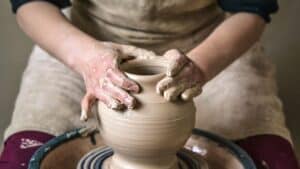Air compressors serve as an essential piece of equipment for airbrush artists.
Depending on the size of the project and the artist’s specialization, picking a suitable air compressor is imperative for a consistent and worry-free experience.
Can you use any air compressor for airbrushing? Any air compressor will get the job don, but the quality, performance, maintenance, and output are heavily affected by which air compressor you purchase. While shop compressors, mini compressors, or even propellant cans can be used, an airbrush compressor is usually best because of the required psi.
Power plays an important factor when it comes to airbrushing.
The recommended amount of power needed for an airbrush is 30 psi. This psi is easily achieved by shop air compressors but is optimized precisely by dedicated airbrush compressors.
Shop air compressor psi ranges from 90-150 while airbrush compressors struggle to reach 43 psi.
Airbrush compressors focus on portability, quality, sound, and optimized power. Shop air compressors forgo noise suppression and mobility for the sake of power.
Optimizing your craft is essential. If you’re doing small jobs, for example, you may refrain from air compressors as a whole and opt for a propellant can.
Propellant cans are for users who aren’t interested in power but instead care about convenience and cost.
The problem consumers face is not knowing their options for air compressors. Fortunately, we’ve researched the pros and cons of each airbrushing option, so you’ll know what works best.
Types of Compressors Suitable for Airbrushing
The preferred airbrush compressor is piston based.
The piston-based air compressor offers more power and a higher air volume than oil-based compressors and diaphragm-based compressors.
Regular Air Compressor
The regular air compressor is able to be used for multiple air tools. Air compressors are significantly bigger than a dedicated airbrush compressor, but with that size comes power.
The traditional air compressor boasts a psi of 90 upward to 150. Regardless, they are significantly louder than any other airbrush compressor because of their power and size.
You lose portability, noise control, and affordability when selecting a regular air compressor. Still, you’re gaining power and multi-use ability for other air tools.
Recommended: Craftsman Oil-Free Compressor
This particular air compressor eliminates many of the downsides of the standard air compressor.
While still reaching a psi of 90, this air compressor allows for multi-use airbrush tools while not sacrificing mobility.
While the noise is still relatively loud, it’s not as loud as standard, more stationary air compressors.
Airbrush Compressor
The airbrush compressor serves only one purpose: to use with an airbrush.
Where the airbrush compressor lacks power and multi-use ability, it makes up for with better noise levels and portability.
People wonder how dedicated airbrush compressors are quieter and smaller than regular air compressors.
Dedicated airbrush compressors don’t go beyond 43 psi. Since airbrushes only need 30 psi, airbrush compressors forgo significant power to opt for a smaller and quieter device.
Recommended: Zeny Pro
The Zeny Pro is lightweight, quiet, and has precise air adjustment. Psi pressures reach up to 43, which is more than you’ll ever need for all airbrush jobs.
The Zeny Pro also uses an oil-less piston motor, which means maintenance is relatively nonexistent on top of it being quiet.
Mini Airbrush Compressor
The mini air compressor competes with a dedicated airbrush compressor with a minimal trade-off – sound.
Portable air compressors are regular air compressors but portable. They are focused on multi-use capabilities and try to do as much as a typical air compressor.
Power is present, but the noise of a standard air compressor is still dominant in this mini compressor. While not as loud, it’s still noticeable.
Recommended: Kensun Portable Air Compressor
This air compressor is for those paranoid about the power output of normal airbrush compressors.
The Kensun portable air compressor has outputs of 100 psi, making it a perfect machine for multi-air tool usage and quieter than its stationary brother.
Propellant Can
Propellant cans work well as a substitute for those without an air compressor. Propellant cans have inherent faults, such as being more prone to leaks and no pressure control.
While propellant cans are flawed, the benefits are still there. The propellant can is a fantastic substitute for traditional air compressors if noise is a concern.
Propellant cans also excel at smaller airbrush jobs such as painting figurines and airbrushing shoes.
While it is a cheaper alternative for smaller projects, it’s important to note that the cost will continue to add up as the projects get bigger.
Recommended: Testors Airbrush Propellant
This particular brand of propellant cans is reliable for small jobs. Even if you use an air compressor, having a few of these handy is still good, just in case you need them one day.
Related Questions:
Why Are Airbrush Compressors So Expensive?
The parts inside air compressors affect the costs. For example, a piston-based system is usually more expensive.
The most affordable option is the propellant cans, which ultimately sacrifice motors, engines, and mechanic design in favor of an aluminum-based pressurized can.
The dedicated airbrush compressor is cheaper than a shop air compressor because it reduces power and multi-use functionality for the single purpose, smaller, and quieter machine.
Cost is an essential factor, and it’s important to know what you’re sacrificing for cost.
What Is the Quietest Airbrush Compressor?
Suppose we’re strictly discussing air compressors, without including the propellant cans, then the quietest would be the dedicated airbrush compressors.
The next quietest would be mini air compressors, followed by the loudest, which is a regular air compressor.
Conclusion
Yes, any air compressor will do if you’re looking to airbrush. The trade-offs come in noise, price, and portability.
Each compressor has its perks and benefits, but we recommend weighing what you feel is more important to you.
Whether that’s power, noise, multipurpose capability, or portability, choosing your air compressor depends on your needs and preferences.









